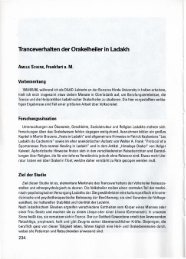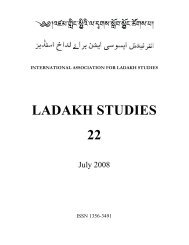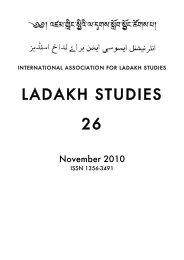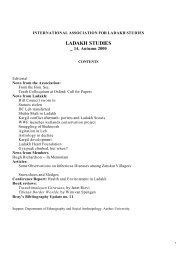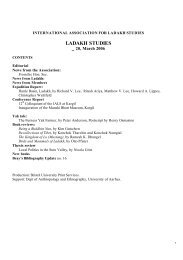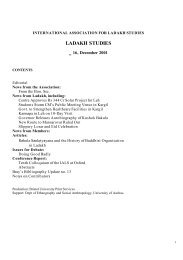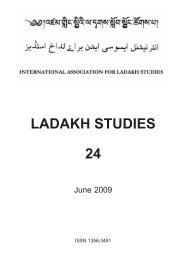LADAKH STUDIES 12, Autumn 1999 - International Association for ...
LADAKH STUDIES 12, Autumn 1999 - International Association for ...
LADAKH STUDIES 12, Autumn 1999 - International Association for ...
Create successful ePaper yourself
Turn your PDF publications into a flip-book with our unique Google optimized e-Paper software.
in caves en route, to sell butter—an estimated 4000 kilograms in 1977—and buy with the proceeds<br />
goods of daily use like tea, cooking-oil, spices and kerosene (Crowden 1994).<br />
This necessarily abbreviated account may yet, I hope, give some indication of the complexity of<br />
the pattern of trade in subsistence commodities that was a critical factor in giving Ladakh economic<br />
independence. (Much more, in my opinion than the more famous and glamorous-seeming longdistance<br />
trades with Yarkand and with Lhasa.) For centuries the unceasing ef<strong>for</strong>t of generations of<br />
peasants and herdspeople—selling, buying and bartering their own and each other’s produce,<br />
increasing its value by carrying it to where it was in short supply, which ipso facto means to where it<br />
would fetch them a reasonable profit, travelling literally hundreds of miles, themselves on foot and<br />
their merchandise loaded on sheep, horses or donkeys or sometimes on their own backs—breathed<br />
life into Ladakh’s economy, lifting it just a fraction above the margin. Up to the middle of this<br />
century, the various trades survived political and other shifts, adapting and evolving according to<br />
circumstances. But between 1947 and 1960 they came to an abrupt end, as a result not of organic<br />
change within Ladakh’s economic system, but of political upheavals in a wider world—the partition<br />
of India, and the communist revolution in China followed by the occupation of Tibet. Their demise,<br />
together with population-growth and the often inappropriate <strong>for</strong>ms taken by Government-sponsored<br />
development programmes, spelt the end of the region’s self-reliance, and the start of an era of<br />
dependence on outside economic <strong>for</strong>ces over which Ladakh has no control.<br />
This paper summarizes part of the author’s Trans-Himalayan Caravans: Merchant Princes and<br />
Peasant Traders in Ladakh, published by Ox<strong>for</strong>d University Press New Delhi.<br />
Bibliography<br />
Crook, John, and Stamati Crook. ‘Explaining Tibetan Polyandry: Socio-Cultural, Demographic and<br />
Biological Perspectives’, in Crook and Osmaston, 1994.<br />
Crook, John and Henry Osmaston, (eds). Himalayan Buddhist Villages: Environment, Resources,<br />
Society and Religious Life in Zangskar, Ladakh. Delhi, Motilal Banarsidass and Bristol,<br />
University of Bristol, 1994.<br />
Crowden, James. ‘Butter-trading Down the Zangskar Gorge: the Winter Journey’, in Crook and<br />
Osmaston, 1994.<br />
Duncan, Jane E. A Summer Ride in Western Tibet. London and Glasgow, Collins, n.d. (First publ.<br />
1906.)<br />
Fürer-Haimendorf, Christoph von. Himalayan Traders. Indian edn, New Delhi, Time Books<br />
<strong>International</strong>, 1988. (First publ. 1975.)<br />
Moorcroft MSS: the Moorcroft MSS in the Oriental and India Office Collection of the British<br />
Library, London. References relate to the European Manuscript Collection (Eur.MSS), of<br />
which the Moorcroft MSS are a part, and to which there is a comprehensive guide in G. Kaye,<br />
India Office Library: Catalogue of Manuscripts in European Languages (vol. II, part 2, section<br />
1), 1937.<br />
Moorcroft, William, and George Trebeck. Travels in the Himalayan Provinces of Hindustan and the<br />
Punjab, &c. London John Murray, 1841. (Repr. New Delhi, Sagar Publications, 1971, and<br />
Karachi, Ox<strong>for</strong>d University Press , 1979.)<br />
Osmaston, Henry. ‘The Farming System’, in Crook and Osmaston 1994<br />
Rivi, Janet. ‘The Trade In Pashm And Its Impact On Ladakh’s History’, in Martijn van Beek,<br />
Kristoffer Brix Bertelsen and Poul Pedersen (eds), Ladakh: Culture, History, and Development<br />
between Himalaya and Karakoram. Proceedings of the Eighth Colloquium of the <strong>International</strong><br />
<strong>Association</strong> <strong>for</strong> Ladakh Studies Held at Moesgaard, Aarhus University, Denmark, 5-8 June<br />
1997. (Recent Research on Ladakh, vol. 8). Aarhus, Denmark, Aarhus University Press, <strong>1999</strong>.<br />
34




